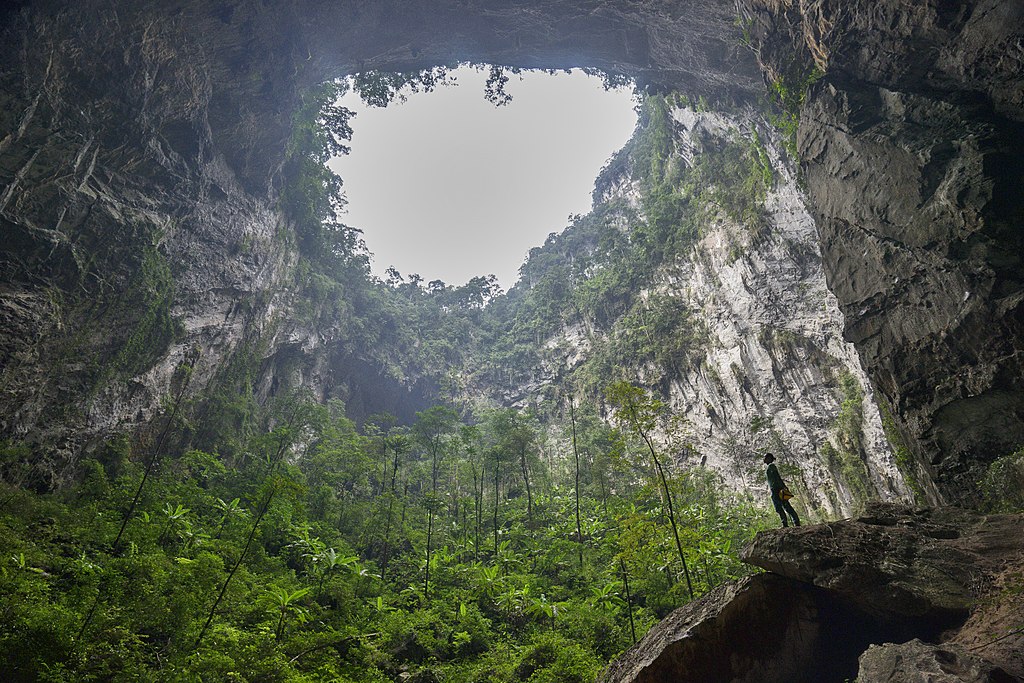The world’s largest cave wasn’t found until 2009 & contains a jungle & its own weather system

It’s sometimes easy to believe that as the world has become smaller and more connected in the modern age and there is nothing left to discover or explore. However, the largest cave in the world was only brought to the rest of the globe’s attention in 2009.
Scroll down for video
If something that large can remain more or less hidden for so long, there must be many even more amazing discoveries waiting for the right explorer.

In 2009, a team comprised of scientists from Hanoi University of Science and members of the British Cave Research Association from England were looking for caves in the Phong Nha region of Vietnam.
Judging by caves that had already been discovered, the scientists expected to find another rather large cave in the vicinity but had not had any luck during the six years they were surveying, at least in part because the area was so remote and difficult to access according to the Geológico y Minero.

After learning that the scientists were looking for caves, one of their local guides, Ho Khanh, told them that in 1990 while sheltering from a storm in the jungle, he’d found the mouth of a cave where he could feel wind and hear rushing water.
However, because the entrance was very steep, he did not explore it and had never gone back.

The scientists asked Khanh to try to find the entrance again and after a few attempts he was able to lead them there. The wind emanating from the entrance was so strong it could be felt from almost a third of a mile away. What followed was the exploration of Hang Son Doong, which translates roughly as “Mountain River Cave.”
Although the entrance is relatively small, about 98 feet by 32 feet, the immense cave itself is over 5.5 miles in length, and one single chamber is over 3 miles long, 650 feet high, and 490 feet wide. According to Business Insider, this is large enough to fit a 40-story building and is the largest cave in the world.

The rushing water Khanh had heard was the Rao Thuong River which cascades through the cave system. This, and the fact that many portions of the cave’s roof have collapsed and admit sunlight, has allowed a unique underground jungle ecosystem to flourish and creates a unique localized weather system inside the cave.
Animals such as monkeys, flying foxes, snakes, and birds reside within Hang Son Doong’s jungle, and many of the plant and animal species are very rare.
Few people have visited Hang Son Doong because of the remote location and its recent discovery. Furthermore, only one company has permits to provide tours, which for a demanding five day expedition costs upwards of $3 thousand dollars. According to CNN, each expedition to the cave requires “two caving experts, three local guides, two chefs, two park rangers and 20 porters” to take care of the tourists.

The expedition itinerary includes camping on two separate nights in the world’s third largest cave, Hang En, in a campsite considered to be one of the most magnificent in all of Asia.
This cave is also part of the Phong Nha-Ke Bang National Park, and the Rao Thuong River flows through it as well. The entrance to this cave is impressive, measuring over 390 feet high and nearly 460 feet wide.
While on the trek, tourists can expect to see stalagmites more than 230 feet high according to Time. Stars are visible through holes in the roof of the cave at night, and there are even sandy beaches along the route.
https://www.youtube.com/watch?v=h6n5p0W1nLc
Hang Son Doong contains a rare phenomenon known as cave pearls — spherical rock-like formations that are created from calcium salts layering over tiny pieces of sediment for thousands of years.

A trek to Hang Son Doong would be the trip of a lifetime. Because so few people visit it, and it is so remote, it’s still virtually untouched by humanity.
It would be wonderful if, in the future, it became more accessible, but perhaps not at the expense of ruining the natural beauty as it has been for thousands of years. It’s amazing to think that it was only explored for the first time in 2009, and exciting to consider what else might be discovered in years to come.
